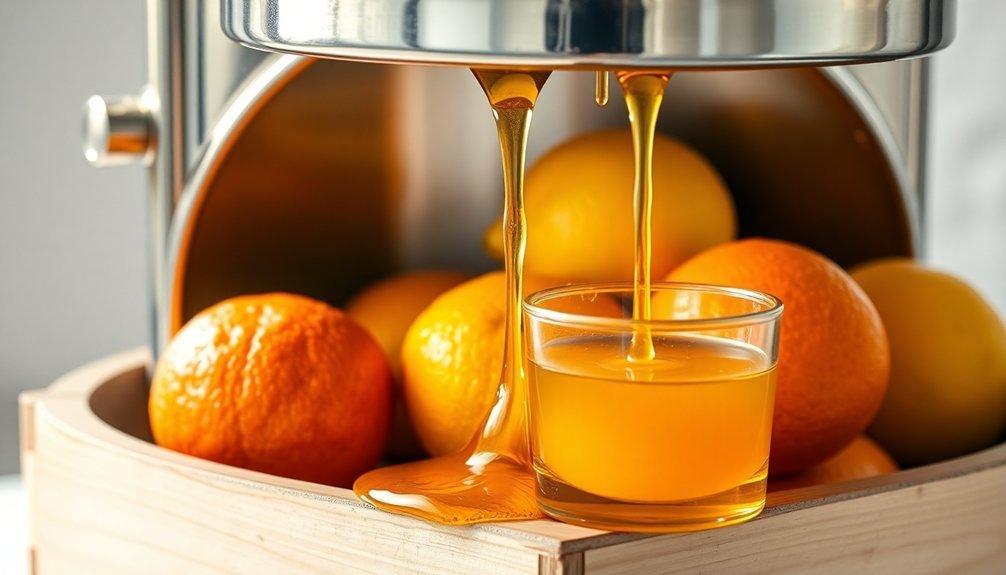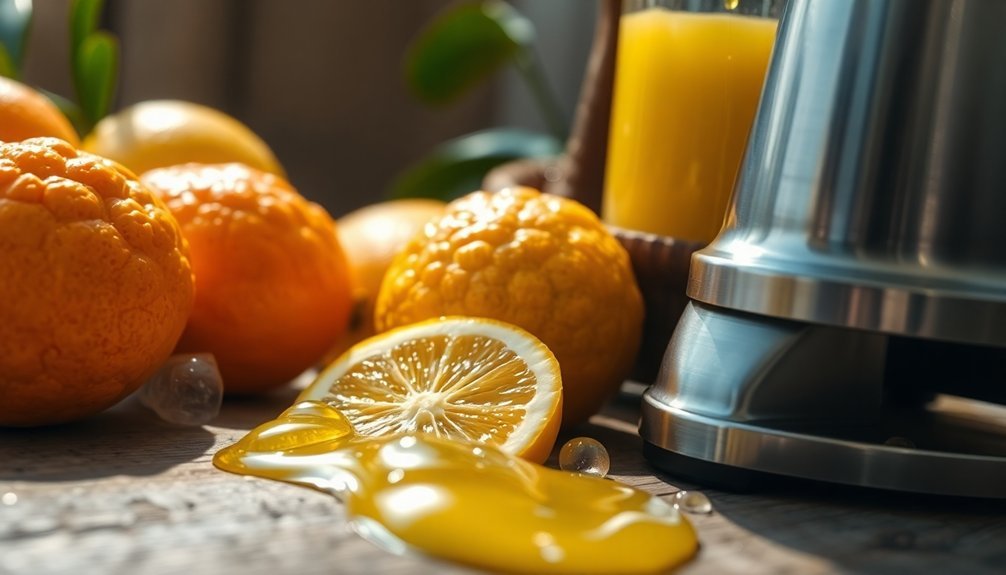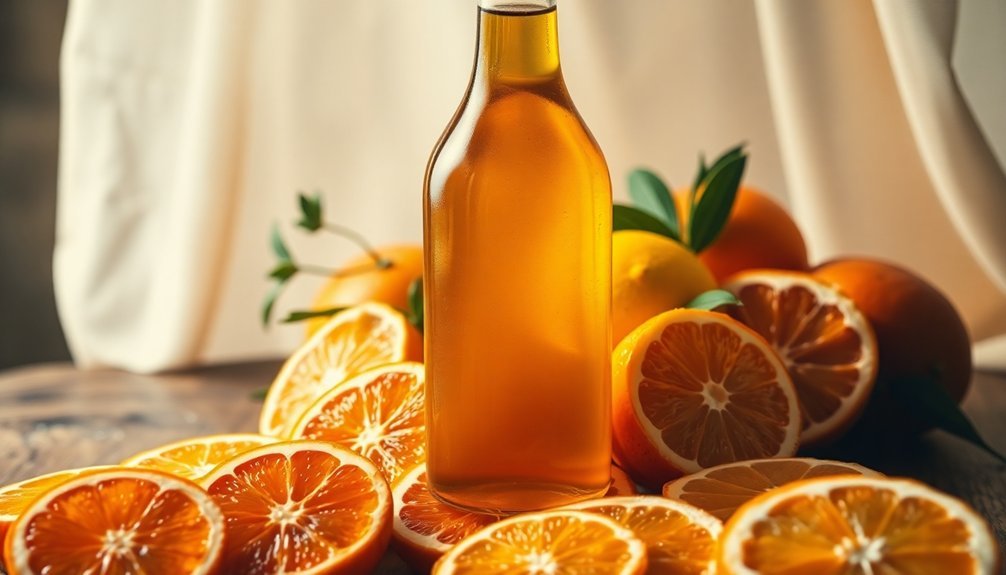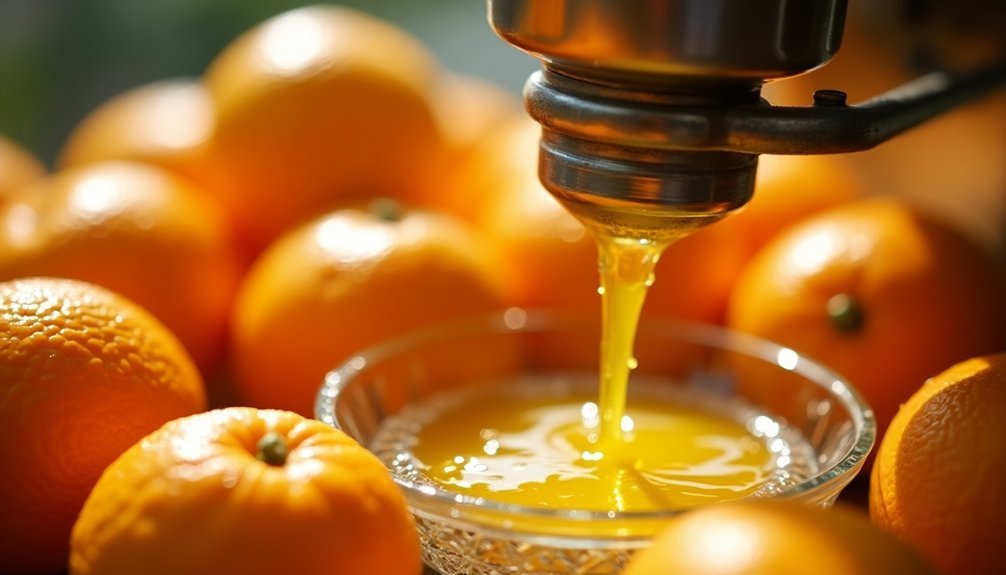You'll find seven key methods for cold-pressing citrus oils: manual peel pressing, spiral roller extraction, needle drum processing, high-pressure water washing, centrifugal separation, automated mechanical systems, and slow juicer extraction. Each technique preserves the oil's natural properties by avoiding heat and chemicals during processing. Modern equipment can handle 4-30 MT/hour depending on the fruit type, while manual methods offer smaller-scale solutions. Discover how these methods can transform your essential oil production journey.
Understanding the Basic Principles of Cold-Press Extraction

While many extraction methods exist for obtaining essential oils, cold pressing stands out as a purely mechanical process designed specifically for citrus fruits. You'll find the essential oils in the fruit's epicarp, or outer skin, which makes this method particularly effective.
When you're cold pressing citrus oils, you're using a mechanical device with spikes to puncture and scrape the peels. As you press the fruit, the oils release and mix with water to form an emulsion. This technique was first introduced in Italy during the 1800s.
You'll then need to separate this mixture through centrifugation to isolate the pure essential oil.
What makes this method special is that it doesn't use heat or solvents, so you're preserving the oil's natural compounds. You'll get vibrant, complex flavors and intense aromas that truly capture the essence of the original fruit.
Essential Equipment and Tools for Cold-Press Method
A reliable cold-press extraction system depends on several key pieces of equipment working in harmony. You'll need high-quality stainless steel components, including gears, shafts, and a specialized needle drum for piercing oil cells. The ALFA method technology ensures optimal processing for different citrus varieties. The system's automation controls let you adjust settings based on fruit characteristics while monitoring real-time performance.
| Component | Benefit |
|---|---|
| Spiral Roller | Moves fruit efficiently along axis |
| Needle Drum | Guarantees thorough oil cell extraction |
| Spray System | Washes and collects oil effectively |
| Control Panel | Optimizes processing parameters |
Your extraction system's success relies on its modular design, which simplifies maintenance and operation. The linear structure makes installation straightforward, while embedded electronics regulate fruit flow for consistent processing. With these tools, you'll achieve maximum oil yield while maintaining product quality and operational efficiency.
Step-by-Step Manual Cold-Press Technique

Three main stages define the manual cold-press technique for extracting citrus oils: preparation, pressing, and separation.
You'll need to start by thoroughly cleaning organic citrus peels, removing the white pulp, and letting them dry completely. Once dry, cut the peels into thin strips or zest them for ideal oil extraction. This method produces oils that smell like fruit rinds.
Here's what you'll achieve with proper technique:
- Maximum oil yield through careful preparation of your citrus peels
- Pure essential oil extraction without heat degradation
- Superior quality oils with preserved natural compounds
Press your prepared peels using manual pressure or a slow juicer, collecting the liquid mixture that emerges.
You'll then need to separate the essential oil from other liquids through natural settling or centrifugal separation.
Finally, strain the mixture and store your extracted oil in a dark, airtight container.
Modern Mechanical Cold-Press Systems
Modern mechanical cold-press systems represent a technological leap in citrus oil extraction, combining precision control with automated efficiency.
You'll find these systems can electronically adjust to different citrus varieties and conditions, optimizing oil extraction in real-time through networked sensors and instrumentation.
The machines process 4-16 MT/hour for lemons and 8-30 MT/hour for oranges, using high-pressure water to wash off the oil before collecting it in stainless steel tanks.
They're equipped with a two-stage defect removal system and intelligent alarms that report to both HMI and iOPS gateway.
You can monitor and control the entire process through cloud-based platforms, accessing management information via internet browsers or mobile devices.
The systems track recipes and log data, ensuring you'll achieve maximum yield through efficient separation of oil, water, and pomace.
Optimizing Oil Yield Through Proper Fruit Selection

Selecting the right citrus fruits is essential for maximizing essential oil yield during cold-press extraction. You'll need to take into account the ripening stage, variety, and overall fruit condition to achieve the best results. The best yields typically come from fruits at medium to advanced ripeness, when essential oil concentration peaks in the peels.
- Choose cultivars known for high oil content, such as specific varieties of *Citrus sinensis*, and make sure they're grown under suitable climate conditions.
- Check the Brix/Acidity index (aim for around 7) and inspect fruits for undamaged surfaces and proper moisture content.
- Handle your selected fruits with care during transport and storage, and minimize the time between harvest and extraction to preserve volatile compounds.
Remember that uniform fruit quality and proper postharvest handling will greatly impact your extraction success.
Quality Control Measures in Cold-Press Processing
To maintain consistent quality in cold-pressed citrus oils, you'll need to monitor and control several critical parameters throughout the extraction process.
Start by checking the raw material's moisture content and ensuring proper particle size optimization, typically ranging from 0.16mm to 2mm depending on your equipment specifications.
You'll want to carefully regulate your cold press machine's feed rate and rotation speed to prevent temperature increases that could compromise oil quality.
Monitor the pH levels of your expressed emulsion, as they'll indicate proper acid solubilization from the peels.
Pay attention to the compression force and number of pressing cycles to maximize yield without sacrificing quality.
After extraction, implement proper filtration and centrifugation steps to separate the oil from the aqueous emulsion effectively.
Store your final product in conditions that prevent oxidation.
Storage and Preservation of Cold-Pressed Citrus Oils

Proper storage of cold-pressed citrus oils plays a vital role in maintaining their quality and extending their shelf life.
You'll need to store them in stainless steel vessels or dark glass bottles, keeping them away from light and heat exposure. Remember to maintain a storage temperature close to 0°C and guarantee complete water absence through centrifugation.
- Use amber or cobalt blue glass bottles, never plastic, and always keep caps tightly sealed to prevent oxidation.
- Store oils in a refrigerator to slow oxidation, especially for citrus oils that typically last 9-12 months.
- Fill containers completely or use inert gases like nitrogen to minimize air contact, and consider decanting into smaller bottles for rarely used oils.
These practices will help preserve your oils' quality and maximize their shelf life.
Frequently Asked Questions
How Long Does Cold-Pressed Citrus Oil Remain Fresh and Viable?
You'll get the best quality from your cold-pressed citrus oils within 9-12 months when stored properly. If you keep them refrigerated in dark bottles, they can last up to 2 years with good viability.
Can Cold-Pressed Oils Be Safely Used Directly on Skin Without Dilution?
No, you shouldn't apply undiluted cold-pressed citrus oils directly to your skin. They can cause severe photosensitivity, chemical burns, and inflammation. Always dilute them with carrier oils according to recommended safety guidelines.
What Happens to the Fruit Pulp After Cold-Press Extraction?
You'll find the leftover pulp doesn't go to waste. You can use it for making jams, animal feed, compost, or biofuel. It's rich in fiber and nutrients, making it valuable for various applications.
Why Do Cold-Pressed Citrus Oils Cost More Than Steam-Distilled Versions?
You'll pay more for cold-pressed citrus oils because they need lots of raw fruit, require expensive equipment, involve time-consuming processes, and maintain strict quality standards to preserve their natural therapeutic properties.
How Many Citrus Fruits Are Needed to Produce One Ounce of Oil?
You'll need several dozen citrus fruits (typically 25-30 oranges or more) to produce one ounce of oil. The exact amount varies depending on your fruit type and whether they're fresh or aged.
In Summary
Cold-press extraction gives you the purest citrus oils when you follow proper techniques and quality controls. You'll get the best results by selecting fresh, ripe fruit and maintaining clean equipment throughout the process. Whether you're using manual methods or modern machinery, proper storage in dark glass containers will preserve your oils' potency. Now that you've learned these seven methods, you're ready to start producing premium citrus oils.





Leave a Reply